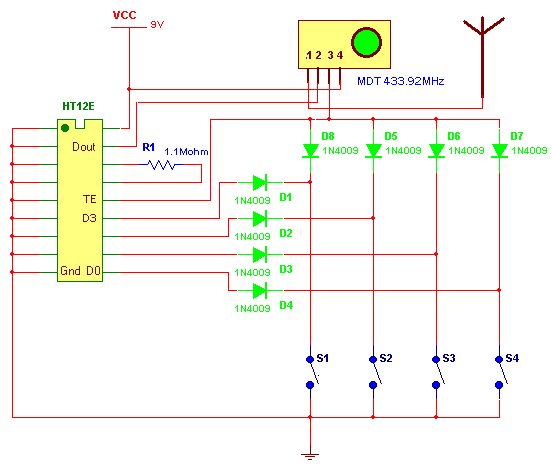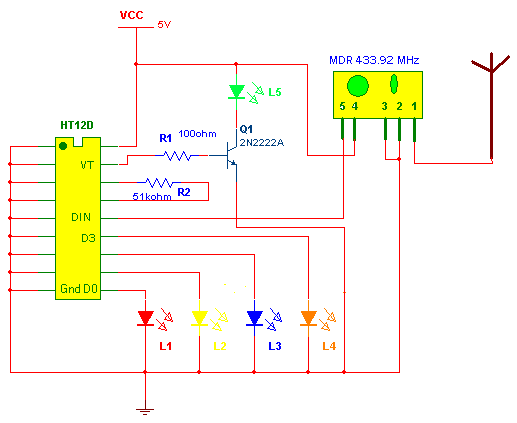This ASK based remote control using very popular encoder-decoder chips HT12E & HT12D. These chips are widely used for remote control applications. Special ASK transmitter and receiver modules are used to transmit and receive digital code. It has carrier frequency of 433.92 MHz and operating range of around 100-150 mts.
Transmitter:-
The figure given in circuit diagram tab 1 shows schematic diagram of transmitter using IC HT12E
Connections:- As shown in figure all the address lines A0-A7 are connected to ground. You can either connect all the lines to Vcc or to ground but keep in mind that on the receiver side you have to do same. This is to set same address both the sides. Resistor R1(1.1M Ohm) is connected between oscillator pins (Osc1 & Osc2) to set transmitter frequency = 50×Receiver Frequency. Data lines D0-D3 are connected with switches S1-S4 through diodes D1-D4 respectively. The other terminal of all the switches is connected with ground. The TE pin (transmission enable) is also connected to all the switches through four different diodes D5-D8. The Dout pin of HT12E is connected to Din pin of 433.92MHz serial data transmitter. 9V standard battery supplies power to the circuit.
Operation:-
· Whenever you press any key TE pin will be grounded through that diode, at the same time particular data line is also grounded.
· So we can set the data at the same time we can pull the TE pin low by pressing single key
· Now we know when TE pin is low the address and data are transmitted serially through Dout pin.
· So 8-bit address and 4-bit of data are together transmitted over 433.92 MHz carrier frequencies.
Receiver
Receiver:-
Receiver circuit using IC HT12D is shown in circuit diagram tab 2.
Connections:- All the address lines are connected to ground to set same address. Resistor R2 (51K Ohm) is connected between Oscillator pins. All the data line D0-D3 are connected to different LEDs L1-L4 respectively. LED L5 is connected to VT (valid transmission) pin through transistor Q1 to indicate valid transmission. The Dout pin of 433.92 MHz serial data receiver is connected with Din pin of IC HT12D.
Operation:-
· When 5V supply is given to circuit all the data lines are low so LEDs will not glow.
· Whenever you press any switch from Tx address & data are transmitted together
· The 433.92MHz serial data receiver will demodulate the carrier and gives this address & data to IC HT12D
· IC HT12D first compares the address three times and if it matches it gives high pulse on VT pin (so LED L5 will blink) and latch the data.
· Suppose you pressed ‘S4’. So the data transmitted will be 1110 and address will be of course 00000000.
· HT12D receives the signals compares address thrice, gives high pulse on pin VT and then latch the data. Because data is 1110 LED L1 will not glow and rest all the LEDs will glow.
· Same way if you press ‘S2’ data will be 1011. So now LED L3 will be off and rests are on.
· Simply you can see which ever switch is pressed on Tx side that particular data line is low on Rx side.
Project Source Code
Circuit Diagrams
Filed Under: Electronic Projects




Questions related to this article?
👉Ask and discuss on EDAboard.com and Electro-Tech-Online.com forums.
Tell Us What You Think!!
You must be logged in to post a comment.